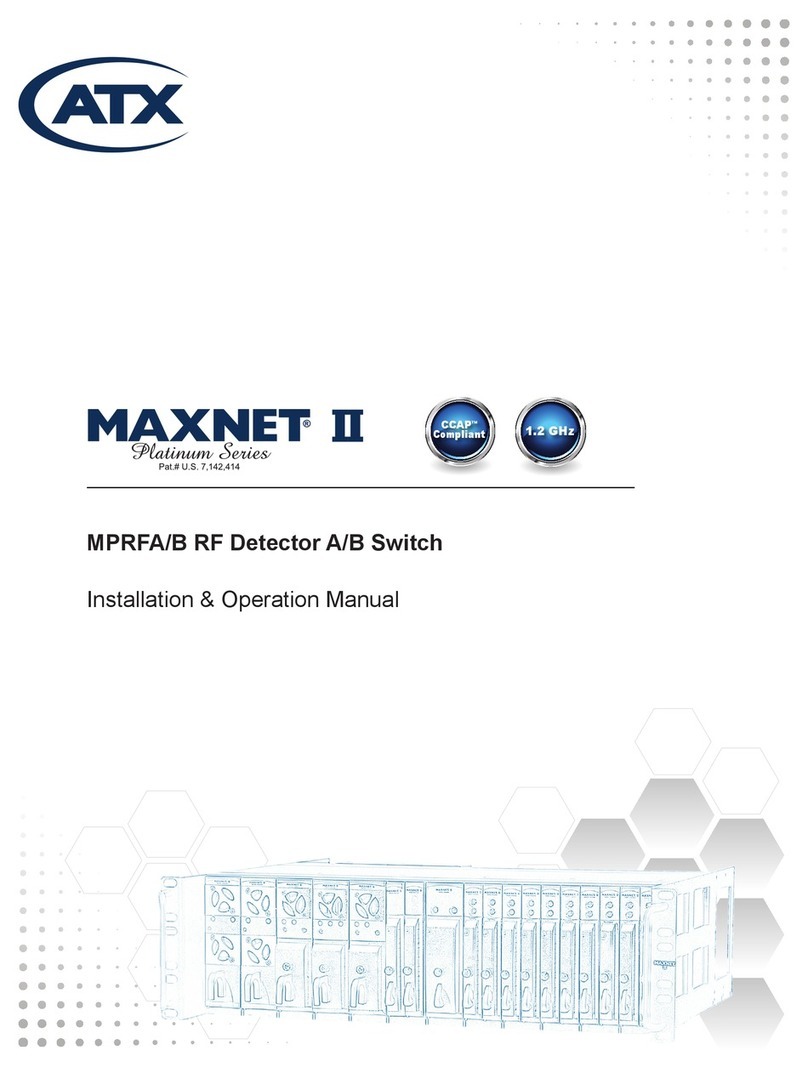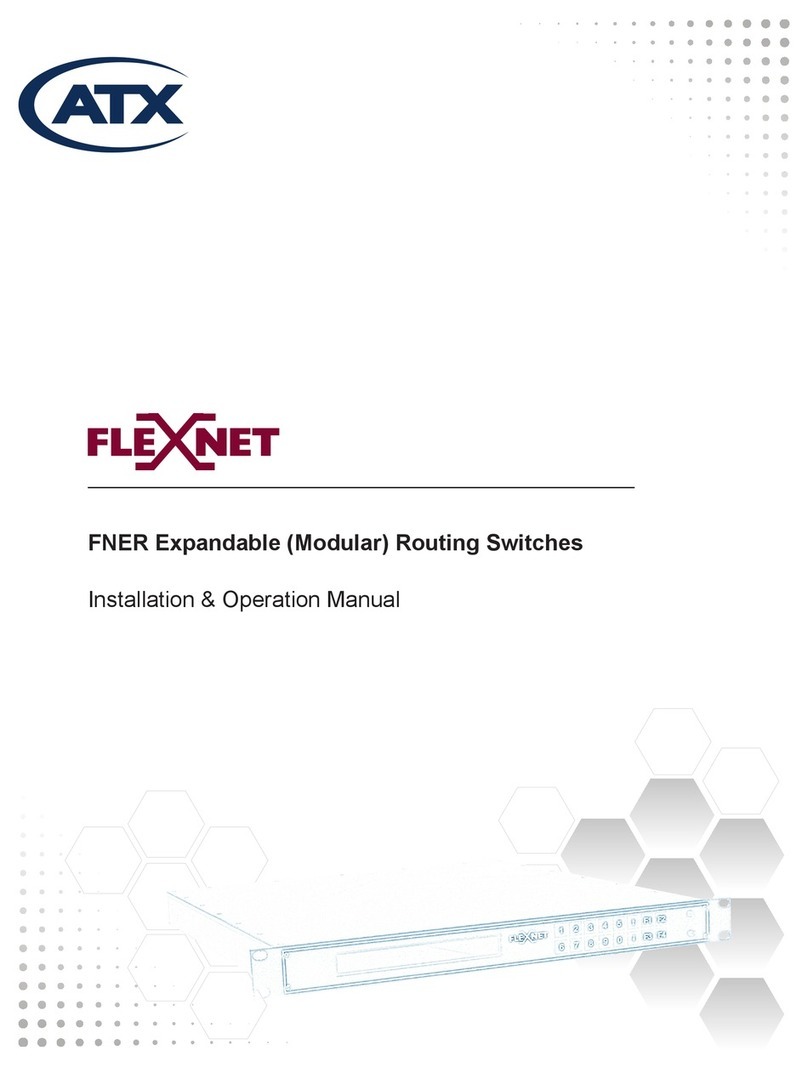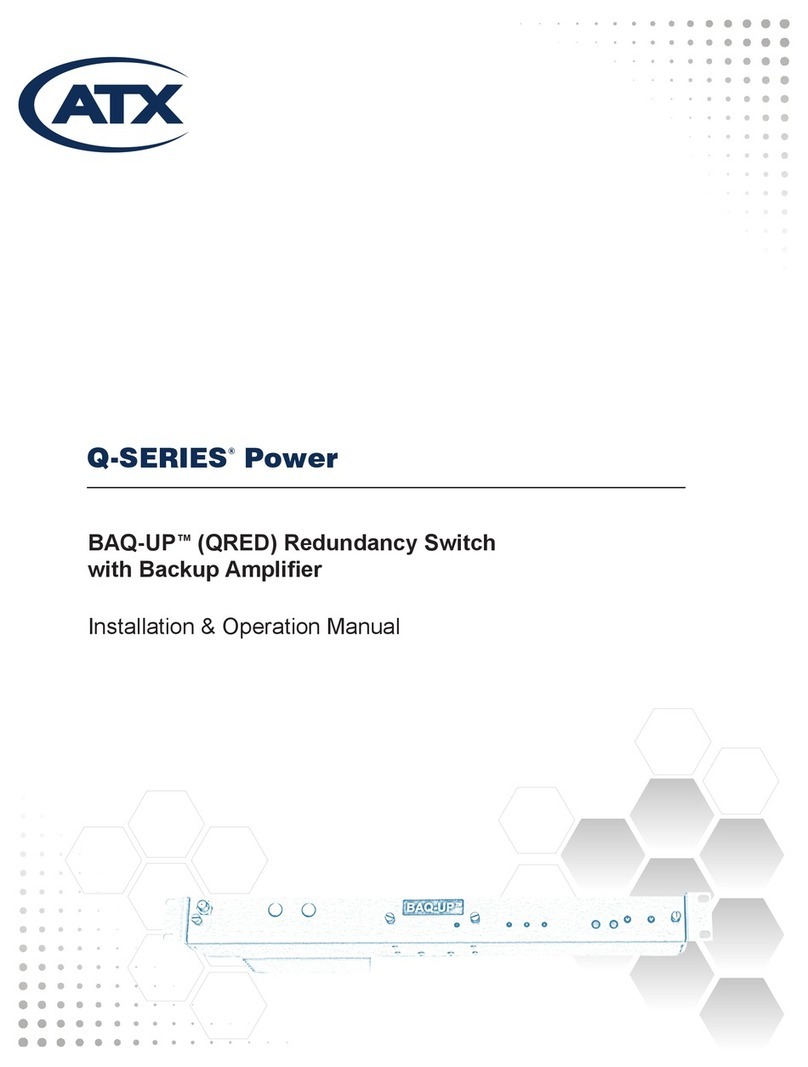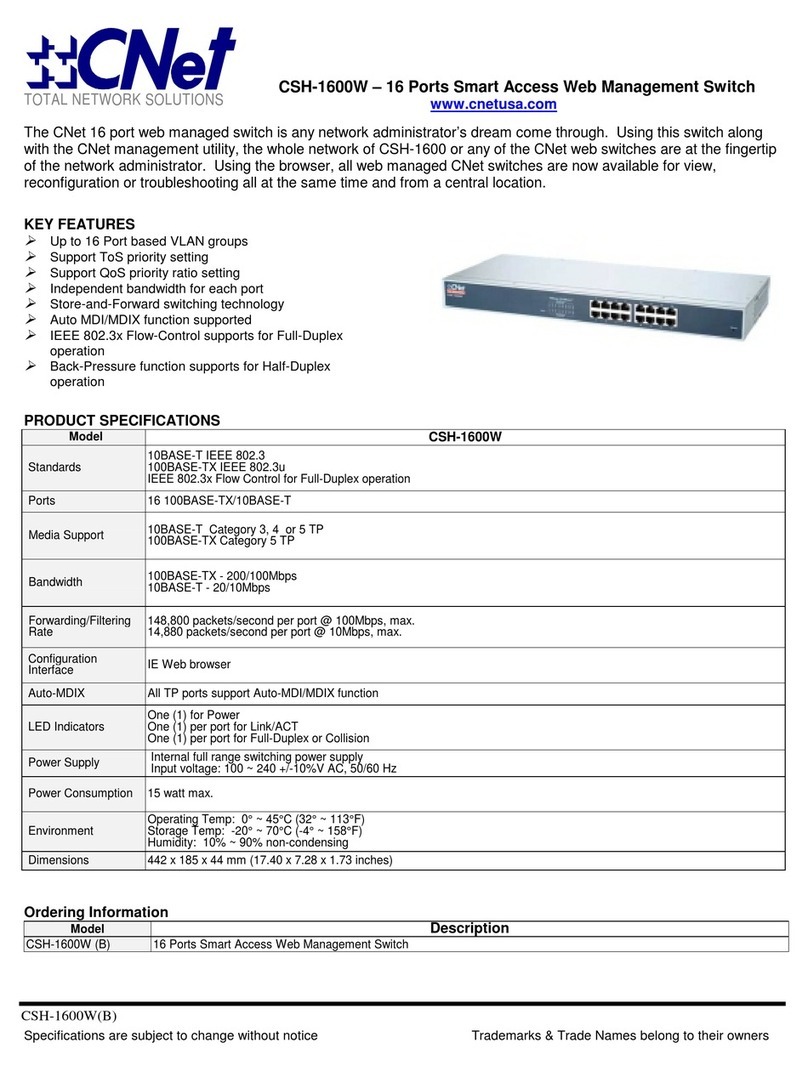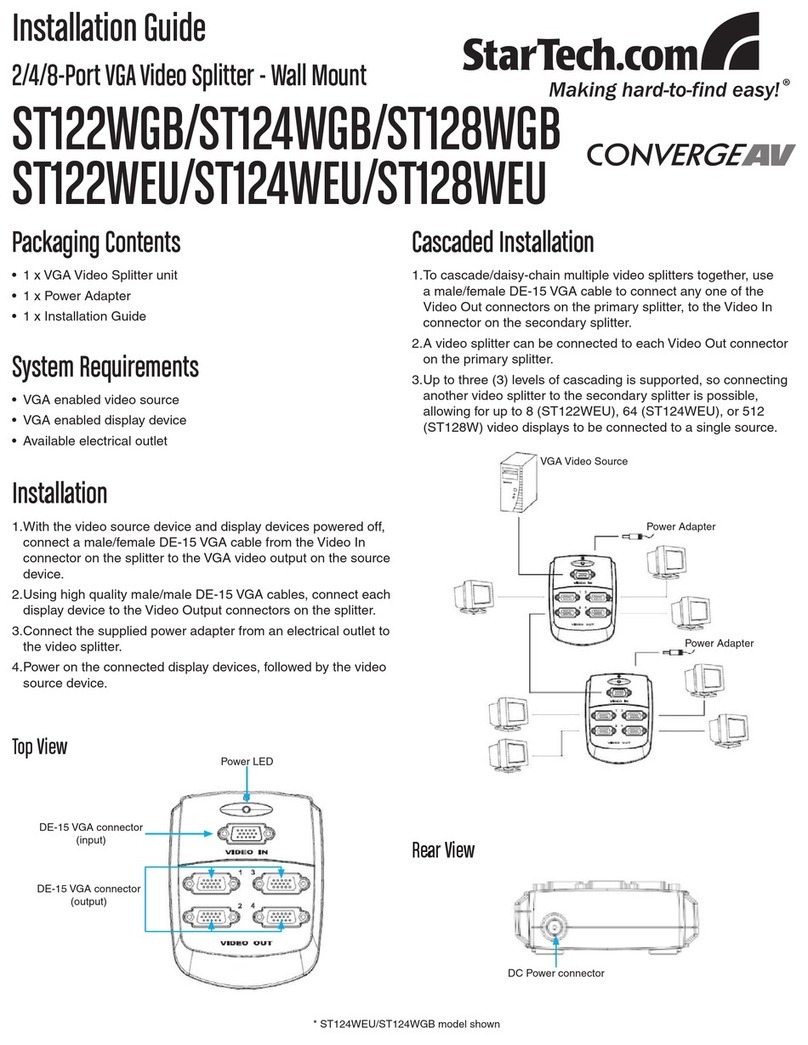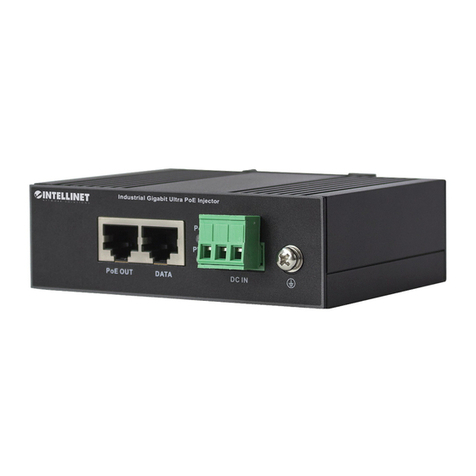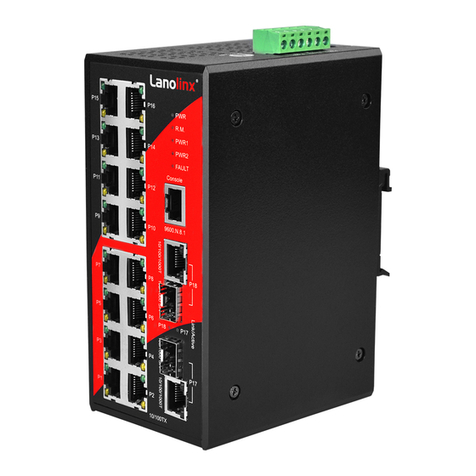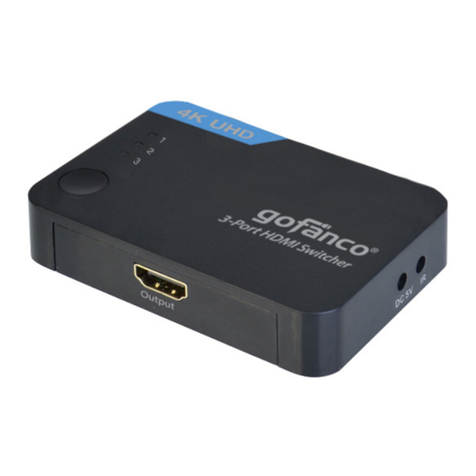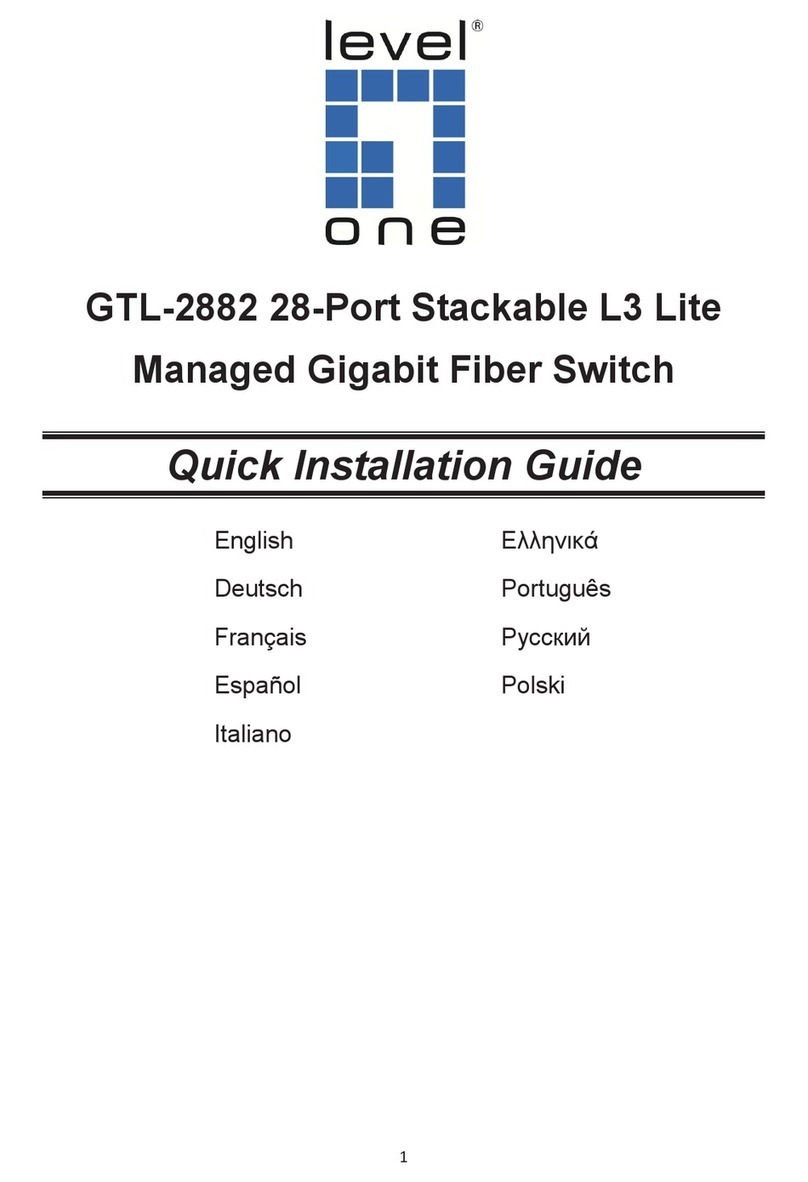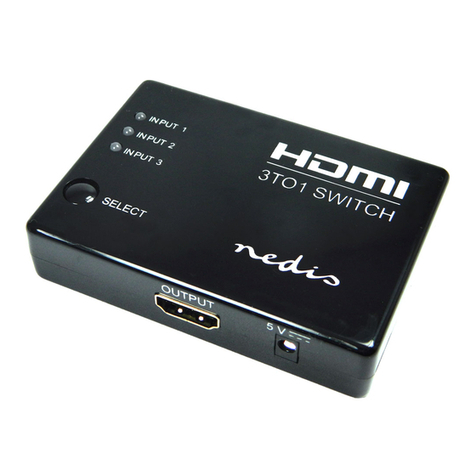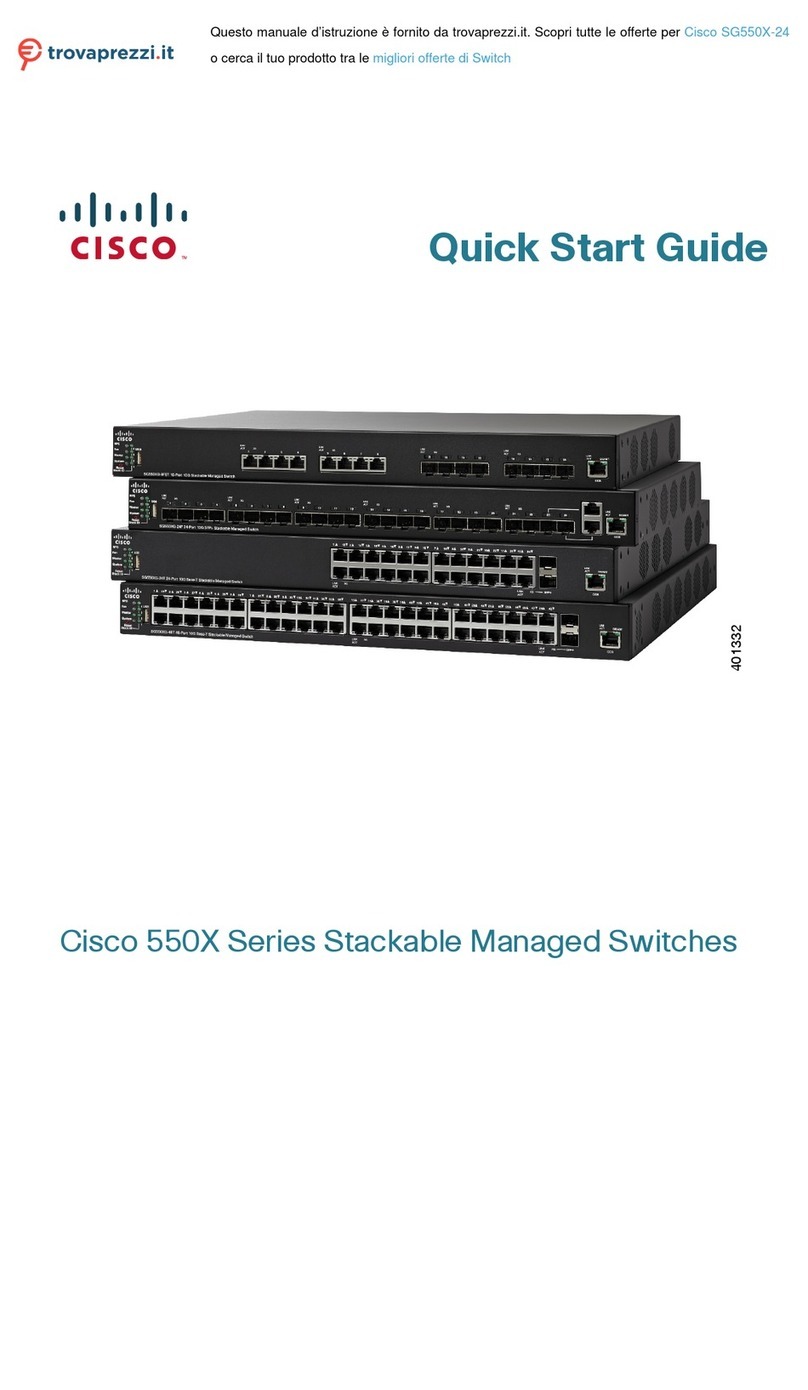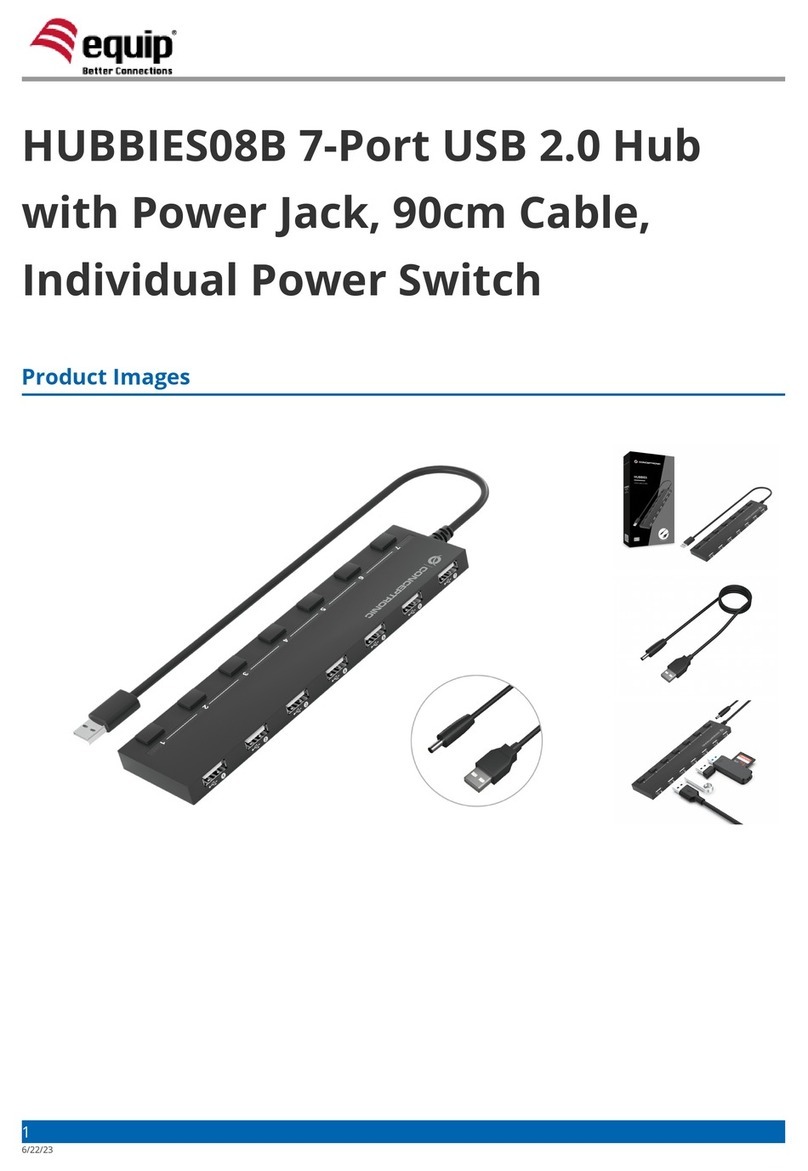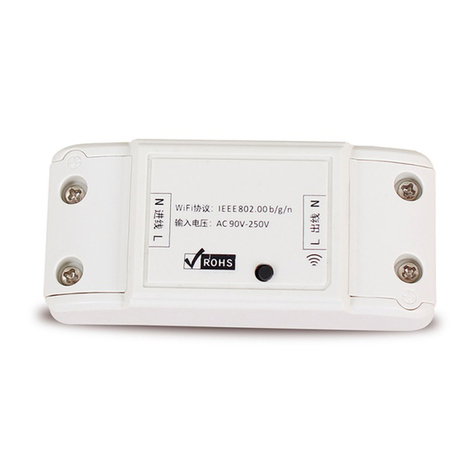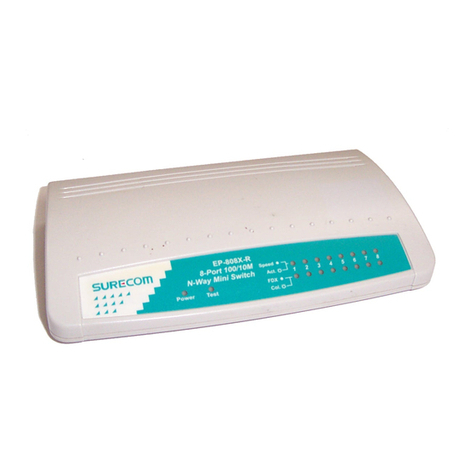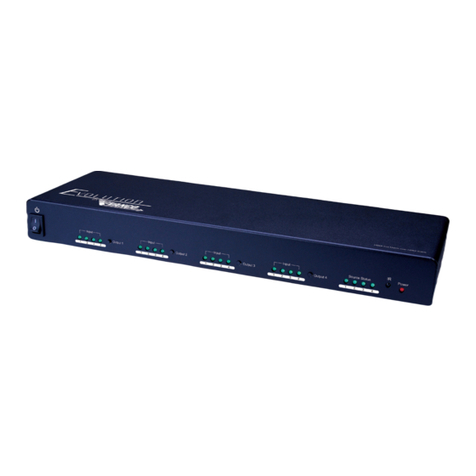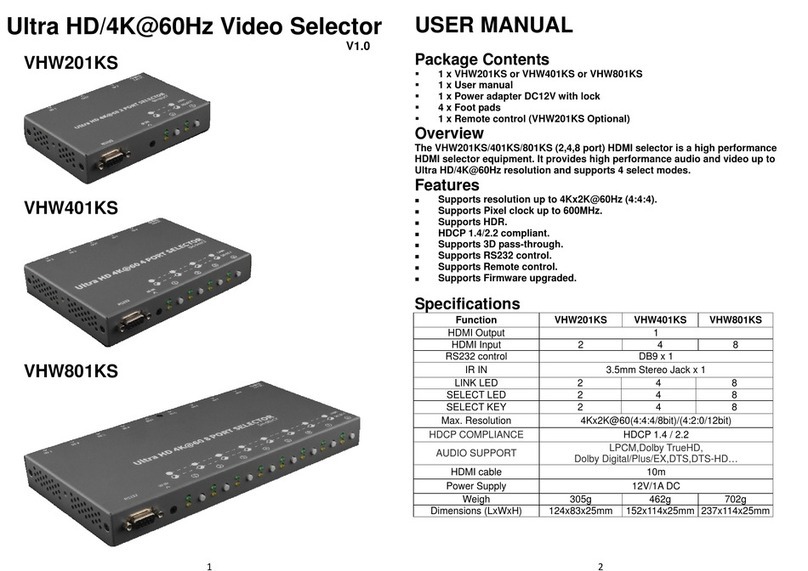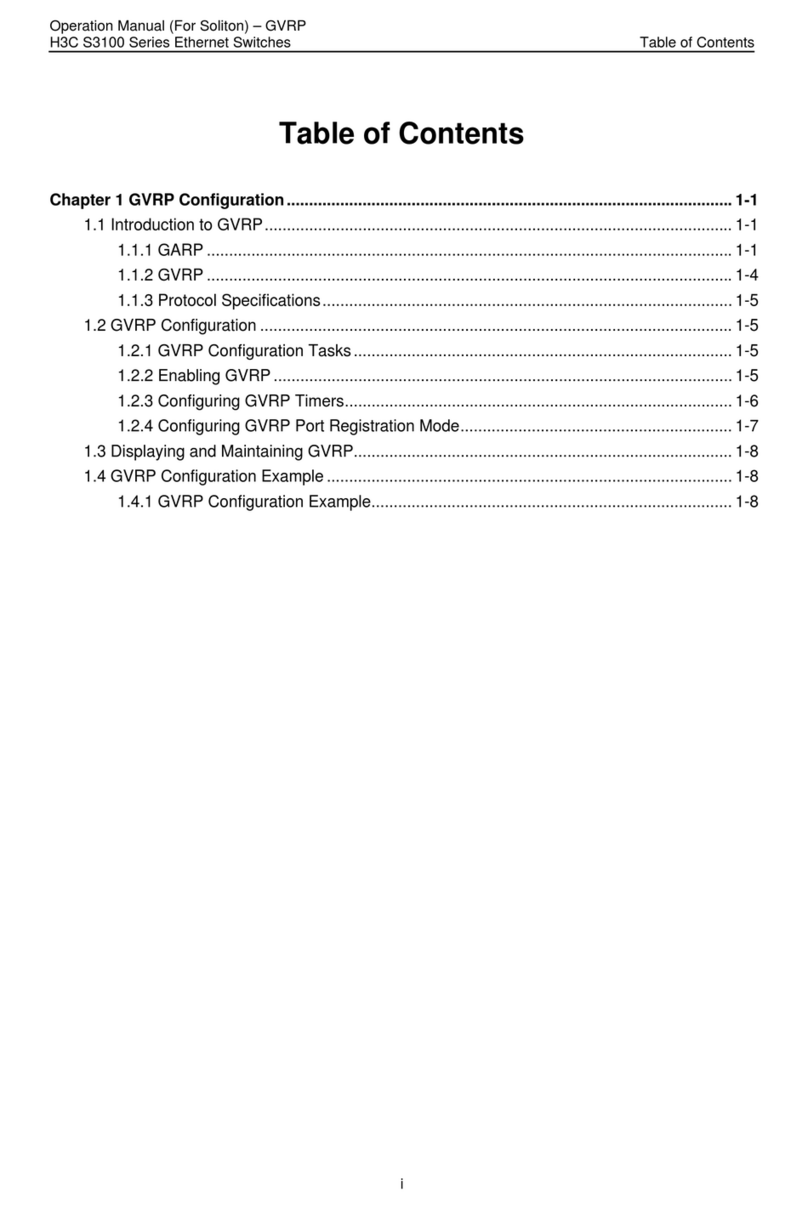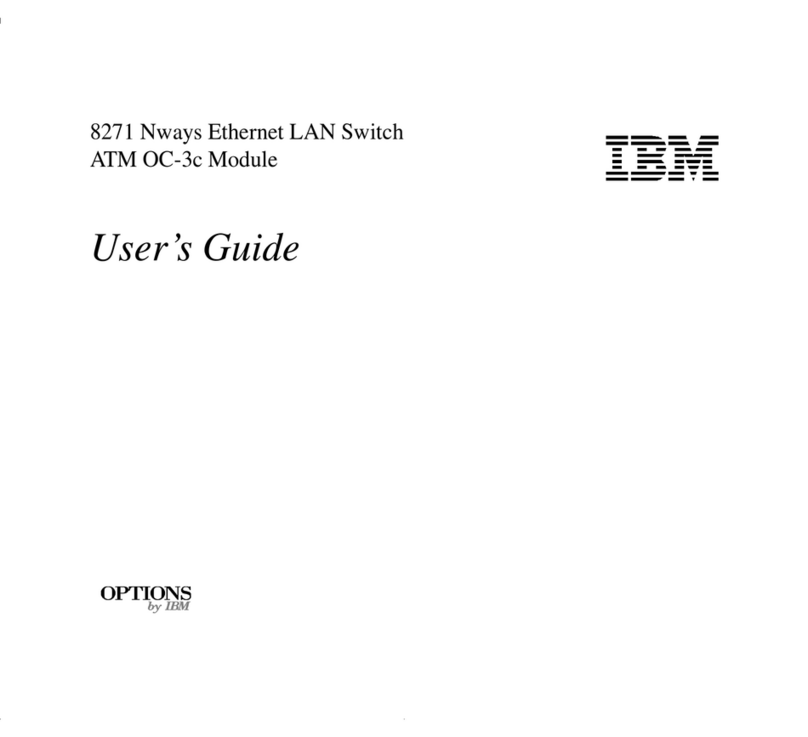ATX SignalOn Series User manual

RF Switch Module
User Manual
Although every effort has been taken to ensure the accuracy of this document it may be necessary, without notice, to make amendments or correct omissions.
Specications subject to change without notice.
SignalOn®Series

SignalOn®Series is a registered trademark of ATX in the United States and/or other countries. Products or features contained herein may be covered by one or more U.S. or
foreign patents. Other non-ATX product and company names in this manual are the property of their respective companies.

TABLE OF CONTENTS
Page
Introduction........................................................................................................................................................ iii
Admonishments ................................................................................................................................................ iii
General Safety Precautions.............................................................................................................................. iii
Certication........................................................................................................................................................ iii
FCC Compliance Statement ............................................................................................................................. iii
1. GENERAL.................................................................................................................................................. 1-1
1.1. Compatibility with RFWorx®Product Line.......................................................................................... 1-1
2. PRODUCT DESCRIPTION........................................................................................................................ 2-1
2.1. RF Switch Module Congurations ..................................................................................................... 2-1
2.2. Features ............................................................................................................................................ 2-1
3. APPLICATIONS......................................................................................................................................... 3-1
4. SPECIFICATIONS ..................................................................................................................................... 4-1
5. INSTALLATION ......................................................................................................................................... 5-1
5.1. Alarm Connections ............................................................................................................................ 5-1
6. SYSTEM OPERATION .............................................................................................................................. 6-1
6.1. Input RF Level Calibration................................................................................................................. 6-3
6.2. RF Input Level Calculation ................................................................................................................ 6-3
6.3. Protection Switching.......................................................................................................................... 6-4
6.4. Alarm Contact Closure ...................................................................................................................... 6-4
7. SERVICE & SUPPORT.............................................................................................................................. 7-1
7.1. Contact ATX Networks....................................................................................................................... 7-1
7.2. Warranty Information ......................................................................................................................... 7-1
7.3. Safety ................................................................................................................................................ 7-1
i

Index of Figures and Tables
Figures
#1 Single RF Switch Module.......................................................................................1-1
#2 Dual RF Switch Module .........................................................................................1-1
#3 General Application Amplier Redundancy............................................................3-1
#4 General Application Path Redundancy..................................................................3-1
#5 RF Switch Module Installation 2RU Chassis .........................................................5-1
#6 RF Switch Module Installation 5RU Chassis .........................................................5-2
#7 Single RF Switch Module.......................................................................................6-2
#8 Dual RF Switch Module .........................................................................................6-2
Tables
#1 Physical and Environmental Specications ...........................................................4-1
#2 Electrical Specications.........................................................................................4-1
#3 Rear Panel Connections and Switches .................................................................6-1
#4 Front Panel Indicators and Control........................................................................6-1
#5 RF Input Level Calculations...................................................................................6-3
#6 Switch Logic...........................................................................................................6-4
ii

Introduction
The SignalOn Series RF Switch Module is designed to be installed in the 8- or 20-position SignalOn Series chassis. Each
RF switch module occupies two positions in the chassis. The mechanical dimensions, cable management, and aesthetics
of the RF Switch Module are compatible with the SignalOn product line. The system is designed to accommodate superior
cable management and ease of use.
Admonishments
Important safety admonishments are used throughout this manual to warn of possible hazards to persons or equipment.
An admonishment identies a possible hazard and then explains what may happen if the hazard is not avoided. The
admonishments — in the form of Dangers, Warnings, and Cautions — must be followed at all times. These warnings are
agged by use of the triangular alert icon (seen below), and are listed in descending order of severity of injury or damage
and likelihood of occurrence.
Danger: Danger is used to indicate the presence of a hazard that will cause severe personal injury, death, or substantial
property damage if the hazard is not avoided.
Warning: Warning is used to indicate the presence of a hazard that can cause severe personal injury, death, or substantial
property damage if the hazard is not avoided.
Caution: Caution is used to indicate the presence of a hazard that will or can cause minor personal injury or property
damage if the hazard is not avoided.
General Safety Precautions
Warning: Never install equipment in a wet location or during a lightning storm.
Certication
SignalOn Forward Path products have been tested and found to comply with the requirements of UL 60950, and CSA 22.2
No. 0.7, emissions EN55022 radiated and conducted.
FCC Compliance Statement
The SignalOn Forward Path Amplier product line has been certied to comply with the requirements for class A computing
devices per part 15 of the FCC regulations.
Warning: This equipment generates, uses, and can radiate radio frequency energy and if not installed and used in accordance
with the instruction manual, may cause interference to radio communications. It has been tested and found to comply with
limits for a Class A digital device pursuant to Subpart B of Part 15 of FCC Rules, which are designed to provide reasonable
protection against such interference when operated in a commercial environment. Operation of this equipment in a residential
area is likely to cause interference to TV and radio reception in which case the user, at their own expense, will be required to
take whatever measures may be required to correct the interference.
This equipment does not exceed Class A limits for radio emission for digital apparatus, set out in the radio interference
regulation of the authorization methods of Industry Canada. Operation in a residential area may cause unacceptable
interference to TV and radio reception requiring the owner or operator to take whatever steps are necessary to correct the
interference.
SignalOn®Series – RF Switch Module User Manual iii
PREFACE

PREFACE
SignalOn®Series – RF Switch Module User Manual iv
This page left intentionally blank.

GENERAL
1. General
The SignalOn system is a modular system that permits high isolation combining, splitting, switching, and amplication of
headend signals in a CATV system. The system is designed to accommodate strong cable management, EMI shielding, and
ease of use. This facilitates easy reconguration and high performance within a dynamic headend environment.
The SignalOn RF Switch Module (RFSM) is designed for use with the SignalOn 8-position, or 20-position powered chassis.
All RF connections to the switch are made through standard 75 Ohm BNC, or F connectors located on the rear. All operating
controls and indicators are located on the switch front panel with conguration controls located on the rear.
Each SignalOn RF Switch Module (RFSM) occupies two positions in a chassis. Up to nine RFSMs and one power supply,
or eight RFSMs and two load-sharing, redundant power supplies can be installed in a vertical 20-position (5RU) SignalOn
chassis. Ten RFSMs may be installed in the vertical 20-position SignalOn chassis if an external +24 VDC power source
is used.
Each RFSM or power supply occupies two positions in a chassis. Up to three RFSMs and one power supply, or two RFSMs
and two load-sharing, redundant power supplies can be installed in a horizontal 8-position (2RU) SignalOn chassis. Four
RFSMs may be installed in the horizontal 8-position SignalOn chassis if an external +24 VDC power source is used.
Switch modules are shown in Figure 1 and Figure 2.
1.1. Compatibility with RFWorx®Product Line
SignalOn switch modules, ampliers and power supplies may be installed in the same chassis as the SignalOn Passive
modules. They are not physically compatible with the earlier RFWorx®chassis.
SignalOn®Series – RF Switch Module User Manual 1-1
CHAPTER 1: GENERAL
Figure #1: Single RF Switch Module Figure #2: Dual RF Switch Module

SignalOn®Series – RF Switch Module User Manual 1-2
CHAPTER 1: GENERAL
This page left intentionally blank.

PRODUCT DESCRIPTION
2. Product Description
Primary function of the module is to monitor the RF signal gain on the operating primary “A” input, and switch to the backup
“B” input if the gain of the primary path rises, or falls below the calibrated RF input level of the unit. If the “A” input side goes
above, or falls below the threshold of the unit, the RFSM quickly switches the input from the failed input to the secondary
input. Switching occurs in less than 10 milliseconds. Switch status, failure LEDs, and RF level bar graphs are located on the
front panel of the switch module.
2.1. RFSwitchModuleCongurations
• Single Circuit Redundant RF Switch Module - BNC Connector
• Single Circuit Redundant RF Switch Module - F Connector
• Dual Circuit Redundant RF Switch Module - BNC Connector
• Dual Circuit Redundant RF Switch Module - F Connector
2.2. Features
• Continuous monitoring of primary and secondary paths
• Wide power detector range: >50 dBm
• Detects both high and low power failures
• User-selectable switching threshold: ±3 dB or ±6 dB
• Fail-over switching time <10ms
• Front-panel LED status and dual power level displays
• Alarm contact for remote failure monitoring
• Available in BNC and F-Connector congurations
• Single, or Dual modules
• Easily congured for redundancy or A-B switch applications
• Front panel bar graph display provides indication of RF power and switching threshold
• Indication of switch status provided by front panel LED and rear terminal block contacts
• Easily congured switching threshold levels via rear DIP switch
• One-step calibration
• Auto switch-back feature to primary input
• Built-in delay to prevent from false switching
• Automatic or Manual modes of operation
• Latching relays in signal path preserves service in case of power failure
SignalOn®Series – RF Switch Module User Manual 2-1
CHAPTER 2: PRODUCT DESCRIPTION

SignalOn®Series – RF Switch Module User Manual 2-2
CHAPTER 2: PRODUCT DESCRIPTION
This page left intentionally blank.

APPLICATIONS
3. Applications
Typical applications of this switch are to protect two optical to RF receivers, or redundant ampliers. In this setup, the RFSM
can independently protect one or two pairs of receivers, or ampliers. Once the RFSM detects a signal level rising above, or
falling below the preset threshold level, it switches from A to B or B to A for that RFSM. Status conditions for all switches are
available locally through the front panel controls.
The RFSM in the Figure 3 and Figure 4 may be user congured to suit different applications, two methods are shown. A
customer may elect to use two ports from a passive combiner module to supply identical signals to redundant ampliers A
and B. The RFSM would then monitor each amplier output signal and switch to the other amplier as necessary for 1:1
redundancy.
The RFSM can also be congured as a conventional A-B switch, where a main input is passed, and a different back-up signal
may be automatically or manually switched to.
Either conguration of RF switching reverts back to the RF-A signal path once it has been restored, after a short hold-off time
of 15 seconds. This is referred to as Auto Switchback. Either input (A or B) may be selected manually to facilitate system
maintenance, or left to run in AUTO mode as a redundant switch or RF selector.
Each RFSM is designed with latching relays. If power to a module fails, relay contacts retain the selected path and the
calibration data is stored.
SignalOn®Series – RF Switch Module User Manual 3-1
CHAPTER 3: APPLICATIONS
SATELLITE
MICROWAVE DOWN
CONVERTER
BASEBAND
VIDEO/AUDIO MODULATOR
DOWN
CONVERTER
BASEBAND
VIDEO/AUDIO MODULATOR
BASEBAND
VIDEO/AUDIO MODULATOR
COMBINER/
SPLITTER
AMP
A
AMP
AMP
AMP
B
RFSM
TO
CABLE
PLANT
OPTICAL
TRANSMITTER
VCR
OFF-AIR SIGNALS
Figure#3:GeneralApplicationAmplierRedundancy
RFSM
RF OUT
RF IN A
PRIMARY
PATH
RF IN B
SECONDARY
PATH
Figure #4: General Application Path Redundancy

SignalOn®Series – RF Switch Module User Manual 3-2
CHAPTER 3: APPLICATIONS
This page left intentionally blank.

SPECIFICATIONS
4. Specications
Specications are noted in Table 1, and Table 2.
SignalOn®Series – RF Switch Module User Manual 4-1
CHAPTER 4: SPECIFICATIONS
Table#1:PhysicalandEnvironmentalSpecications
PARAMETER SPECIFICATIONS REMARKS
Physical
Dimensions (W × D × H) 1.7 × 5.9 × 8.5 inches (4.3 ×14.9 × 21.6 cm)
Weight
Single
Dual
1.54 pounds (0.7 kg)
1.86 pounds (0.8 kg)
Environmental
Operating Temperature 0°C to +50°C (+32°F to +122°F)
Storage Temperature –40°C to +70°C (–40°F to +158°F)
Storage Humidity 20 to 90% No condensation
Table#2:ElectricalSpecications
DESCRIPTION PARAMETER
Power Consumption
Single
Dual
1.0 W Max.
2.0 W Max.
Impedance 75 Ohms
Frequency Range of Operation 5 MHz to 1 GHz
Frequency Range of Detection 50 MHz to 1 GHz
Operating Input Level –28 dBm to 22 dBm
Insertion Loss 5 MHz–870 MHz<1 dB /
870 MHz–1 GHz>1.15 dB
Flatness <0.8 dB ±0.5 dB
Return Loss 5 MHz–870 MHz>20 dB /
870 MHz–1 GHz>18.5 dB
Switching Threshold ±3 dB (±0.5 dB) / ±6 dB (±0.5 dB)
Isolation between Signal Paths >60 dB
Isolation between Circuits (Dual unit) >70 dB
Alarm Contact Rating 1 Amp max.
EMI (Near Field) >90 dBc, 50 to 1000 MHz
EMI - Radiated and Conducted Emissions CISPR22 Class A

SignalOn®Series – RF Switch Module User Manual 4-2
CHAPTER 4: SPECIFICATIONS
This page left intentionally blank.

INSTALLATION
5. Installation
Each RF switch module occupies two slots in the chassis. Use the following procedure to install modules in the SignalOn
Series chassis.
1. Make sure the ATX logo (or any other front panel lettering) is readable. Align the power connector at the top of the
module with the power connector in the chassis. Slide the plugin module into its designated location in the chassis.
Warning: Never install equipment in a wet location or during a lightning storm.
2. Secure the module using its two captive retaining screws. See Figure 5 or Figure 6.
3. After each module is loaded into the chassis, refer to your work order, and connect the designated RF cables to the
appropriate BNC or F connectors on the modules in the chassis.
4. Carefully route cables through the cable management slots located on each side of the rear of the chassis. Use the
cable management guidelines found in this manual to route cable from the chassis to the rack/cabinet.
5. Perform any cabling or operational tests required at your facility.
5.1. Alarm Connections
Alarm is activated by a relay contact closure when a loss of an input signal occurs or a loss of power at the RFSM. Connect
any pre-existing alarm system to the terminals on the rear of the switch module. Repeat the connection process for the
second switch on the dual switch module.
SignalOn®Series – RF Switch Module User Manual 5-1
CHAPTER 5: INSTALLATION
POWER CONNECTOR
(FACING CENTER
OF CHASSIS)
SINGLE RF
SWITCH
MODULE
Figure #5: RF Switch Module Installation 2RU Chassis

SignalOn®Series – RF Switch Module User Manual 5-2
CHAPTER 5: INSTALLATION
DUAL RF
SWITCH
MODULE
Figure #6: RF Switch Module Installation 5RU Chassis

SYSTEM OPERATION
6. System Operation
There are four LEDs and two bar graph indicators, one toggle switch, and a SET button on the front panel of the single switch
module. The dual switch module has two sets of indicators and controls on the front panel. Refer to Table 3 for a description
of the rear connectors and DIP switches. Refer to Table 4 for a description of each indicator and switch. Location of the
indicators and switches are shown in Figure 7 and Figure 8.
SignalOn®Series – RF Switch Module User Manual 6-1
CHAPTER 6: SYSTEM OPERATION
Table #3: Rear Panel Connections and Switches
FUNCTION DESCRIPTION
Power Connector Accepts Power from SignalOn Chassis
OUT RF Output Connection
IN-A Primary RF Input Connection (A)
IN-B Back-up RF Input Connection (B)
6 dB / 3 dB (SW 1) ±3 dB or ±6 dB Switching Threshold
LIM OFF/LIM ON (SW 2) High Limit (+3 dB / +6 dB) Disable
A≠B / A=B (SW 3) B-Relative-To-A
ALM LOC / ALM UNLOC (SW 4) Alarm Lock / Unlock
ALM Relay Contact for External Alarm
Table #4: Front Panel Indicators and Control
INDICATOR COLOR DESCRIPTION
Status GREEN Operating Properly
RED Power or RFSM Failed
IN-A
GREEN RF-Input A is Within Threshold (±3 dB or ±6 dB)
RED RF-Input A is Out of Threshold Limits
FLASHING GREEN Manual Mode
IN-B
GREEN RF-Input B is Within Threshold (±3 dB or ±6 dB)
RED RF-Input B is Out of Threshold Limits
FLASHING GREEN Manual Mode
A-B Status GREEN RF-OUT is Switched to A-IN
YELLOW RF-OUT B is Switched to B-IN
A-AUTO-B (Switch)
Auto Switched to Automatic Mode
A A-IN Manually Switched to OUT
B B-IN Manually Switched to OUT
Bar Graph A Signal Level Display for RF-Input A
Bar Graph B Signal Level Display for RF-Input B
Set Press to Initiate Calibration of RFSM Input Levels

SignalOn®Series – RF Switch Module User Manual 6-2
CHAPTER 6: SYSTEM OPERATION
FRONT VIEW
REAR VIEW
Figure #7: Single RF Switch Module
FRONT VIEW
REAR VIEW
Figure #8: Dual RF Switch Module

6.1. Input RF Level Calibration
Calibration is performed using the SET button. The RFSM compares each RF input level to a user-selected ±3 dB or ±6 dB
switching threshold, and to minimum/maximum input limits. To pass calibration, when B-Relative-To-A Mode is selected, the
power level of B must be within the threshold window of A. The B power level display indicates B’s power level with respect to
the calibrated reference level of Path-A. The minimum/maximum signal levels the RFSM operates at are –28 dBm to 22 dBm
composite input power. Calibration attempts that fail due to signal levels out of the specied range display a red LED on the
appropriate path LED (A or B) and the status LED turns red. To recalibrate the SET button must be held for several seconds.
During calibration several bar graph LEDs may light until just the center two bar graph LEDs light.
During Manual Mode operation, either Path-A or Path-B may be selected. The non-selected path is not monitored and alarm
contacts are closed. The LED & bar graph displays input of the power reference to only the input switches. All calibration
information is maintained and restored once Automatic Mode is again selected.
During Automatic Mode of operation, Path-A is always the primary path, and the RFSM always selects A or switches back to
A if it is in a normal operating state.
The RFSM uses the following path selection criteria during a calibration attempt in automatic switch mode at initial setup as
well as any future resets:
Automatic Mode Examples
Example Action
A passes / B = don’t care Select Path-A
A fails / B = don’t care No change. (Path-A should always pass calibration. If it fails, leave the relay
unchanged).
6.2. RF Input Level Calculation
The proper input level to the switch is determined by two criteria, channel loading (number of channels being transported),
and RF reference Level in dBmV of each individual RF carrier. See Table 5. The exact formula for calculation of RF Input
level to the RFSM is as follows;
dBmV (total power) = dBmV/ch + 10log (# ch)
dBm = dBmV –48.75 (assumes 75 Ohm impedance)
Example; 130 channels each running at +30 dBmV
dBmV (total power) = 30+10Log (130)
dBmV (total power) = 30+(10) 2.114
dBmV (total power) = 51.14 dBmV
dBm = dBmV (total power) –48.75 (assumes 75 Ohm impedance)
dBm = 51.14 – 48.75
dBm = 2.39
SignalOn®Series – RF Switch Module User Manual 6-3
CHAPTER 6: SYSTEM OPERATION
Table #5: RF Input Level Calculations
PER CHANNEL 76 CHANNELS (550 MHz SYSTEM) 130 CHANNELS (870 MHz SYSTEM)
dBmV dBm dBmV Total Power dBm Total Power dBmV Total Power dBm Total Power
0 –48.75 18.81 –29.94 21.14 –27.61
10 –38.75 28.81 –19.94 31.14 –17.61
20 –28.75 38.81 –9.94 41.14 –7.61
30 –18.75 48.81 –0.06 51.14 2.39
40 –8.75 58.81 10.06 61.14 12.39
50 1.25 68.81 20.06 71.14 22.39

6.3. Protection Switching
Upon detecting a path failure, the RFSM switches to the alternate path within 10ms. Table 6 indicates the switching logic of
the RFSM based on input conditions:
6.4. Alarm Contact Closure
Alarms may be activated by relay contact closure when a loss of an input signal occurs or loss of power at the RFSM. Front
panel LED’s also indicate an alarming condition. During Manual mode, the unselected path is not monitored and the alarm
is on.
The alarm is cleared if the RFSM is in automatic mode and all conditions return to the previously calibrated state. If the alarm
is triggered due to a Path A failure, power at Path A must return to within ±2 dB if set to ±3 dB mode or to within ±4 dB if set
to ±6 dB mode. If Path B triggers the alarm the power level must return to ±3 dB or ±6 dB depending on the mode. Placing
ALM LOC/ALM UNLOC switch (dipswitch 4) in the alarm lock position prevents alarms from being cleared unless the RFSM
is re-calibrated, it recovers from a loss of power, or by pressing SET for one second.
SignalOn®Series – RF Switch Module User Manual 6-4
CHAPTER 6: SYSTEM OPERATION
Table #6: Switch Logic
RFSM CONFIGURATION RELAY ACTION
User has Manually Selected Path-A Never Switched; Always on A
User has Manually Selected Path-B Never Switched; Always on B
Auto-mode: Path-A Failure, Path-B is OK Switched to B
Auto-mode: Path- A Failure, Path-B Failed No Change
Auto-mode: Path-B Failure, Path-A is OK Switch to A
Auto-mode: Path-B Failure, Path-A Failed No Change
Auto-mode: RFSM Power Recovery, Path-A is OK, Path-B No Change Select/Switch to A
Auto-mode: RFSM Power Recovery, Path-A Failed, Path-B is OK Select/Switch to B
Auto-mode: RFSM Power Recovery, Path-A Failed, Path-B Failed No Change
Other manuals for SignalOn Series
3
Table of contents
Other ATX Switch manuals
